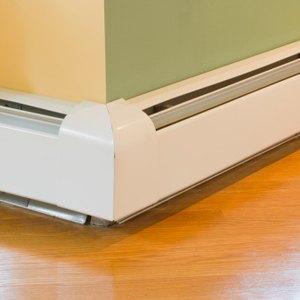
When you create an addition for your home, you want it to be as comfortable as the rest of the house, which means making careful plans to provide for heating the new space. If you simply rely on heat from the original house to drift into the new area, you may end up with a very cold addition.
Options
An addition can be heated using electric baseboards, a propane wall heater, a wood stove or in-floor radiant heat. Which option is best for you depends on how large the addition is, how much money you want to spend up front, how efficient you want your heating system to be and the level of convenience you are looking for. For example, electric baseboards are cheap to install and are convenient but will probably cost you more in operating costs than other methods. A wood stove is relatively inexpensive but will take more work.
Expense
Heating methods often feature an inverse proportion between installation costs and operating costs. Many innovative heating options, such as geothermal heat pumps, are very inexpensive to use but very inexpensive to buy and install. If you are planning to live in your house for the rest of your life, an option such as this might make sense as it will pay for itself over time. How much a wood stove costs to run depends on the price of wood in your area. If you live on a large property and cut your own wood, a wood stove is probably the least expensive way to heat your addition.
Flexibility
If you are interested in keeping your addition separate from your original house when it comes to heat, you want a heating system that can be isolated so that you can heat either the house or the addition independently. This is most easily accomplished if you install an independent heating system rather than extending the ducts from the furnace in your original house. The advantage of creating flexibility in your heating design is that you can leave your addition unheated or at a very low heat when it isn't being used, thus saving a lot of money in heating costs while remaining comfortable in the rest of the house.
Convenience
Some people enjoy tinkering on their houses and doing domestic work while others just want to push a button and be done with it. A system that incorporates solar water panels on your roof and in-floor radiant pipes give out a pleasant and consistent heat, but you will have to pay attention to it to ensure it is running properly. Electric baseboard heaters use up a lot of power and frequently leave chilly areas in a room but can be turned off and on in a second. Consulting with a heating professional before making any decisions can help you to clarify the complexities of domestic heating systems and which one is best for you.
References
Writer Bio
Jagg Xaxx has been writing since 1983. His primary areas of writing include surrealism, Buddhist iconography and environmental issues. Xaxx worked as a cabinetmaker for 12 years, as well as building and renovating several houses. Xaxx holds a Doctor of Philosophy in art history from the University of Manchester in the U.K.

